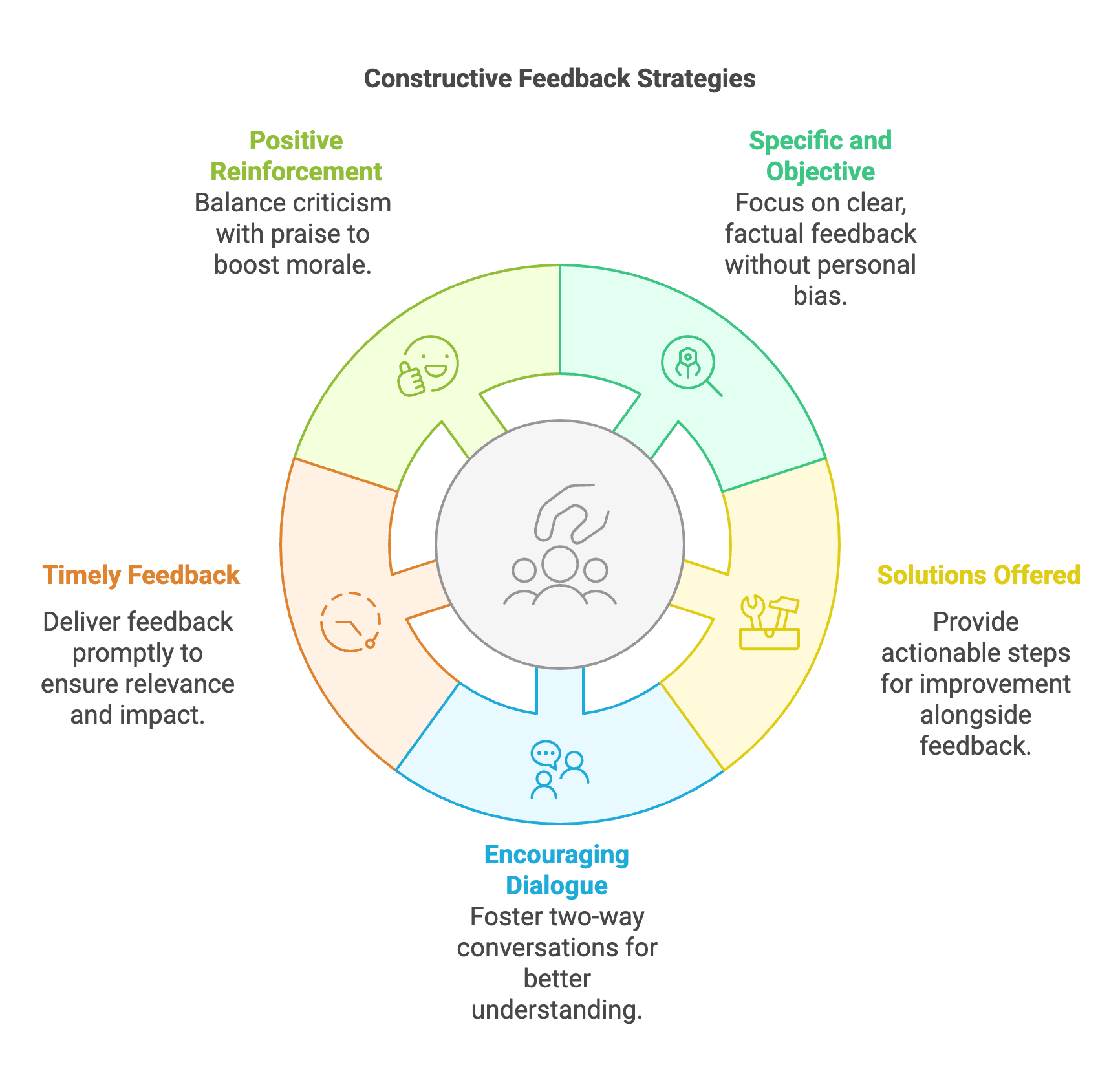Empowering Teams: Addressing Errors with Insight
Managing frequent mistakes and questions from employees is a common yet tricky task. Even though these issues may seem small, they can have significant impacts if not addressed properly.
Repeated errors might indicate skill, understanding, or motivation issues, while frequent questions may signal a need for clearer communication or easier-to-access resources.
Handling these issues can significantly impact a team's overall productivity and morale. A workplace thriving on positive reinforcement, patience, and clear communication can transform these challenges into opportunities for growth and learning. Conversely, a negative or dismissive approach can lead to decreased employee confidence, increased frustration, and a potential decline in team performance.
Leaders and managers must develop effective strategies for addressing mistakes and questions, which can lead to improved workplace productivity and higher employee morale.
Understanding the Root Causes
Identifying the root causes behind repeated errors and questions in the workplace is crucial for crafting effective solutions. These issues often stem from more than just surface-level challenges; they may indicate deeper problems in training, communication, or work culture.
Digging Deeper Than the Surface: Repeated mistakes could indicate inadequate training, unclear instructions, or even personal challenges employees face. Similarly, frequent questions may arise from insufficient onboarding processes or a lack of accessible resources. Looking beyond the immediate problem is essential to understand the underlying causes.
Open Communication Channels: It is vital to establish an environment where employees feel comfortable sharing their concerns and challenges. Regular one-on-one meetings, anonymous feedback options, or open forums can provide valuable insights into why these issues are occurring. Remember, the goal is to understand, not to reprimand.
Active Listening Skills: When discussing these issues with employees, practice active listening. This means fully concentrating on what is being said rather than passively hearing the message. Active listening involves empathy and seeking to understand the employee’s perspective without immediate judgment or dismissal.
Ask the Right Questions: Sometimes, employees may not know why they are struggling. Asking open-ended questions can help uncover deeper issues. Questions like “What challenges are you facing with this task?” or “What can we do to make this information more accessible for you?” can be more insightful than yes-or-no inquiries.
Consider Different Learning Styles: People process information differently. Some might prefer visual aids, while others might benefit from hands-on experience. Understanding and accommodating these different learning styles can be key to resolving repeated errors or questions.
Evaluate Existing Processes and Tools: Sometimes, the problem isn’t the employee but the tools or processes in place. Are the instructions clear and easily accessible? Are the tools efficient and user-friendly? Sometimes, improving or updating these can resolve many repeated issues.
Strategies for Addressing Repeated Errors
While challenging, repeated errors in the workplace offer an opportunity for growth and improvement. Addressing them effectively involves a combination of constructive feedback, additional training and resources, and clear expectations. Here’s how to approach each strategy:
Address the specific error, focusing on the issue, not the person. Avoid generalizations and provide clear examples to illustrate your points.
Alongside pointing out what went wrong, suggest practical ways to improve. This could include steps to avoid future errors or alternative approaches.
Feedback should be a two-way conversation. Allow employees to express their views and concerns, fostering a more comprehensive understanding of the issue.
Provide feedback soon after noticing the error. Regular feedback sessions can also help monitor progress and address issues promptly.
Balance criticism with praise. Recognizing what the employee is doing right can boost their morale and willingness to improve.
Assess if the repeated errors are due to a lack of skills or knowledge. Tailor training sessions to address these specific gaps.
Utilize different training methods like workshops, online courses, or mentorship programs, catering to various learning styles.
Ensure employees have easy access to manuals, guides, or FAQ sections to help them when in doubt.
Regularly review the effectiveness of training programs and make adjustments as necessary to ensure they remain relevant and effective.
Setting Clear Expectations: Communicating Standards Clearly
Clearly articulate the standards and expectations for each role. Ensure that these are communicated effectively to all team members.
Avoid jargon or overly complex instructions. Clarity in communication can significantly reduce misunderstandings and errors.
Written documentation, such as performance standards or job descriptions, helps employees refer to expectations as needed.
As roles and responsibilities evolve, regularly update and communicate any changes in expectations.
Help employees understand how their roles and expectations align with the company's broader goals.
Handling Frequent Questions
Frequent questions from employees, while indicative of engagement and a desire to understand, can sometimes signal a need for more accessible information or empowerment. Addressing this effectively involves creating a knowledge base, encouraging independence, and conducting regular check-ins.
Creating a Knowledge Base: Developing Resources for Common Questions
Identify employees' most common questions and compile them into an FAQ document or section on the company intranet.
Ensure that this knowledge base is easy to navigate and accessible to all employees. Regularly update it with new information and insights.
Motivate employees to share their ideas and solutions to create ownership and teamwork.
Use written documents, videos, or infographics to meet various learning styles.
Encouraging Independence
Encourage employees to try solving problems on their own before asking for help. Offer guidelines on how to tackle common issues or where to find information.
Ensure employees know all the available resources, including the knowledge base, training materials, or contact persons for specific queries.
Acknowledge and value when employees solve problems on their own to encourage this behavior.
While promoting independence, also make it clear that seeking help is not a weakness. Employees should feel supported when they genuinely need assistance.
The Role of Regular Meetings to Address Ongoing Concerns
Regular one-on-one or team meetings let employees ask questions and talk about concerns in an organized way.
Encourage an open-door policy where employees feel comfortable approaching their superiors with questions as they arise.
Use check-ins not only for updates but also to give feedback, share learning chances, and tackle any repeated questions.
Regular check-ins allow leaders to see how well the knowledge base and training are working and whether the number of questions is going down over time.
Fostering a Culture of Learning and Growth
Creating a workplace culture that embraces learning and growth is fundamental to addressing and minimizing repeated errors and questions. Such a culture views mistakes as opportunities for learning and values open communication and ongoing feedback.
Reframing Mistakes as Learning Opportunities:
Promote the idea that skills and intelligence can be developed with time and effort. In this mindset, mistakes are not failures but part of the learning process.
Leaders and managers should openly share their learning experiences, including mistakes and what they learned from them. This approach normalizes errors as a part of everyone’s professional journey.
Recognize and reward success and improvement and the application of new learnings. This can be as simple as acknowledging someone’s effort to correct a mistake or implementing feedback in their work.
Encouraging Open Communication and Ongoing Feedback:
Employees should feel safe to express their ideas, ask questions, and admit mistakes without fear of judgment or repercussions. This can be fostered through regular team meetings, open-door policies, and encouraging peer-to-peer support.
Establish a culture where feedback is continuous and not just confined to formal reviews. Regular feedback helps address issues as they arise and supports ongoing development.
Encourage employees to provide feedback to their peers and superiors. This creates a more dynamic and interactive environment where everyone is involved in each other’s growth.
Investing in Professional Development:
Offer opportunities for professional development, such as workshops, seminars, online courses, or mentorship programs.
Work with employees to create personalized development plans that align with their career goals and the organization's needs.
Encouraging Curiosity and Innovation:
Allow employees the freedom to experiment and explore new ways of doing things. This encourages innovation and can lead to more effective solutions and processes.
Encourage employees to ask questions and explore different aspects of their work and the industry. This nurtures a culture of curiosity and continuous learning.
This not only enhances individual performance but also drives the overall success and adaptability of the organization.
The Role of Leadership
Leadership is pivotal in shaping how workplace errors and questions are handled. The leadership style adopted can significantly influence the frequency of these issues and the team's overall approach to resolving them.
Impact of Leadership Styles on Errors and Questions:
Authoritative Leadership: While this style can ensure clear direction and quick decision-making, it might discourage open communication, leading to more questions and unreported errors.
Democratic Leadership: This approach promotes participation and input from team members, which can lead to a better understanding of tasks and responsibilities, thereby reducing errors and questions.
Transformational Leadership: Leaders who inspire and motivate often encourage a culture of innovation and continuous learning. This can lead to a more proactive approach to addressing errors and a willingness to seek clarification, reducing the recurrence of issues.
Leading by Example:
Leaders who openly embrace challenges, acknowledge their mistakes, and demonstrate a commitment to learning set a powerful example for their team.
When leaders are transparent about the organization's challenges and limitations, it fosters a culture of trust and openness where employees feel comfortable seeking help and admitting errors.
Being Approachable and Supportive:
Leaders who are approachable and available to discuss concerns and questions encourage a more open and communicative work environment.
Focusing on support and solutions rather than blame when errors occur encourages employees to come forward with issues and questions without fear of repercussions.
Encouraging Feedback and Communication:
Leaders who regularly check in with their team can identify potential issues before they escalate. This also provides an opportunity for employees to ask questions and seek clarification.
Providing clear, actionable feedback in a supportive manner helps employees understand what they need to improve without feeling demoralized.
Empowering Employees:
Empowering employees with more responsibility can enhance their skills and reduce their reliance on constant supervision and guidance.
Allowing team members to make decisions and solve problems independently can reduce the frequency of questions and build a more confident and capable team.
Leadership is crucial in how mistakes and questions are managed in an organization. Leaders who encourage open communication, ongoing learning, and support can lower the number of issues and create a better work environment.
Embracing a Proactive and Positive Approach
In addressing the challenges of repeated errors and frequent questions in the workplace, our journey through various strategies highlights a fundamental truth: our approach can transform these challenges into opportunities for growth and improvement.
It's clear that a proactive and positive approach to leadership is beneficial and essential in tackling these common workplace challenges. By embracing these principles, leaders can reduce the frequency of errors and questions and build a stronger, more resilient, and capable team.
This journey isn't just about fixing problems — it's about nurturing an environment where every challenge is an opportunity for growth and every question a step towards greater understanding and efficiency.

















How to unlock your team’s full potential? It starts with asking the right questions. Dive into our guide on 10 strategic questions that can supercharge your team’s growth and productivity. From leveraging neuroscience insights to fostering creative thinking, we’ve got the brainy tips and tricks to make your team unstoppable.